Each year I’ve been ending the calendar year by sharing a selection of the favorite bird photographs I have been able to take, and this week as I was picking out the best of the best, a couple things came to mind. I started with the January file and worked my way through the months in order to December, and the result was not only a selection process, it was a tour of my birding experiences week to week, month by month, season after season – and that was personally exciting, interesting, and inspiring to me. I’m often surprised that I found that bird or that flock, and thrilled that I was able to take each photograph. But it’s really about how I was able to record the essence of that meeting in photographs that have such beauty, and movement, and color, and dynamic resonance to nature where I encounter them.
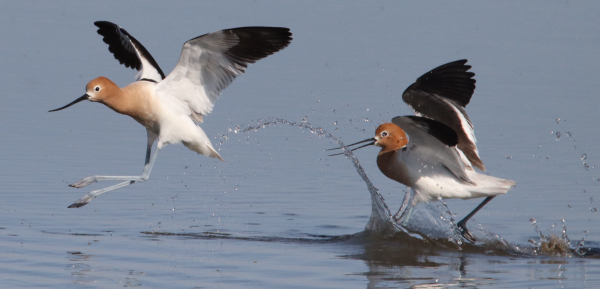
Always alert for the possibility of action photos, while taking a photo of a feeding American Avocet a second avocet landed and began chasing the first, providing the chance for an action sequence. Adding to the flow of this photograph, the stopped action of water makes this image truly unique. While it’s easy to imagine the half-circle of water is following the action of the avocet on the wing, the splash line was actually created by the running steps of the chasing avocet (May photo; 600mm zoom lens, f-8 aperture, 1/4000 shutter speed, 800 ISO).
It's clear the birds are products of the lands, the plants, the waters, and the sky; they behave on solar and seasonal timetables – even their feathers are molted according to their ages and the times of the year. I have always been an observer, often an observer of birds, and I’m a participant too; with a camera I record images, compose a view, and share time in the presence of each of the birds that I photograph. Then I’m able to share photographs with you and tens of thousands of readers through this feature article, and in other articles in this issue. It’s a personal thing to take the photos, to select the images, to tell the stories, and inform you about the hows and ways of photographing birds – and oh what a thrill that is for me!

Perched in full late-afternoon sunlight, a trusting Merlin stretched forward, spreading its tail to its full width as it began lifting its wings above its back in an elegant fashion. I hoped it would continue to spread its wings high, but this was the apex of the wing stretch. This photograph showed the most action among the series of photographs taken during a shared quarter-hour (August photo; 600mm zoom lens, f-8 aperture, 1/2000 shutter speed, 800 ISO).
In this issue of The Birding Wire, there are 3 primary articles in which I present a selection of the favorite photographs I took this year – this Bird Photography feature, my Editor Afield article, and the Bird Portraits article. Each article has a collection of photos that share similar dimensions – first, the best horizontal images are presented in this feature in which photos can be presented in a full-page format. The Editor Afield article has a half-page limit to the width of the images used to illustrate it, so the square-ish and more vertical photos are presented there. The Bird Portraits article is limited in the same half-page way, but it is unique because it is a selection of “portraits” of individual birds I photographed at very close range this year.
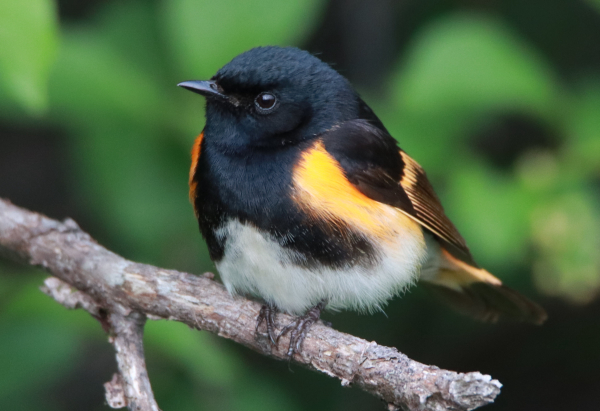
Male American Redstarts were especially active the 4th Friday of May at nearby Melody’s Grove, along with an abundance of other warblers and songbirds during a migration stopover. When you see this close view and the fine details of the redstart in this photo, keep in mind how small this enchanting bird really is (May photo; 600mm zoom lens, f-6 aperture, 1/1000 shutter speed, 1600 ISO).
The idea of the portrait article came to mind as I was selecting photographs from my monthly files and realized I had created a lot of species portraits. Some started out as photos I took of birds that approached very close to my position, usually while photographing from inside my mobile blind (my car). Others are portrait photos I took when I was able to approach birds closer in my car, or on foot. And the third group of portrait-bound photos I took from my bay windows, usually of birds attracted to my feeding station or landscaping. But that was just the first step in making them into portraits; the next step took place in my digital darkroom – my computer, where I use a photo editing program to crop the photograph (Corel PaintShop Pro).
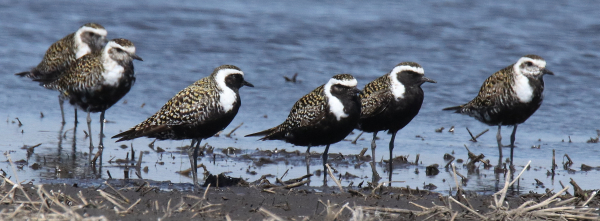
The chance to find American Golden Plovers during a migration stop in the center of the continent provided an especially rare chance to photograph some groups. Individuals in the flock of 20 showed a variety of molt patterns, varying from fully molted to partly molted goldens (May photo; 600mm zoom lens, f-10 aperture, 1/1600 shutter speed, 800 ISO).
After selecting a relatively close photo that is super-sharp on my computer screen when I enlarge it a bit, I open the digital photograph in the photo editing page and simply crop it. I crop it close so the bird’s image almost resembles a high school graduation portrait that accents the head, shoulders, and upper body. Simple enough, but it takes a very sharp photo that was especially close to my camera lens. When selecting the best of the best among my 2025 bird photos, it became evident that I had transformed more images into portraits this year, and that’s when I decided to separate the best portraits to a “portrait-based” Bird Photography article.

Spring isn’t official until the first Baltimore Orioles arrive at my feeding station, where they add color and action to the view outside my bay windows. Soon after the first sighting last May, at least 3 females and 3 male Baltimore Orioles were present along with 2 male Orchard Orioles and 1 female Orchard (May photo: 600mm zoom lens, f-8 aperture, 1/4000 shutter speed, 800 ISO).
My photographs also obviously had seasonal contexts, so I decided to include the month when each of the selected photographs was taken in the captions, thinking that would be interesting for the annual “best of” presentations. However, I stopped short of trying to present the photos chronologically, opting to share a more personal presentation of the selections of bird photos that illustrate each of the 3 photo-oriented articles in this issue.

An especially dramatic view of an adult Ferruginous Hawk as it began to turn in an elegant fashion provided a favorite photograph taken while snapping a series of images in rapid sequence as the raptor was propelled by the brisk west wind toward me in a swift gliding flight (April photo; 600mm zoom lens, f-9 aperture, 1/2500 shutter speed, 800 ISO).
I personally hope you enjoy reviewing the photographs individually and as a gallery of my best and favorite photos from 2025, and I hope you gain some insights and perhaps some inspiration for your own bird photography – or if you aren’t already taking photographs, perhaps these photos will help to interest you into expanding your birding interests into the subset of bird photography. I have long believed that bird photography is one of the most rewarding, most creative, most exciting, and most enjoyable aspects of birding. It’s easy, and yet it is difficult; it’s not very predictable, but we all try our best to take the best possible photographs under the immediate conditions.
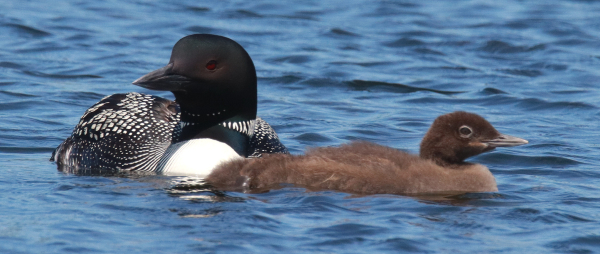
The mid-afternoon sunlight provided perfect highlights in the plumage of this adult and 2-week-old downy Common Loon on a tranquil Minnesota lake. Summer loons have a special attraction for me as they provide exceptional photo ops that have been shared among friends (July photo; 600mm zoom lens, f-10 aperture, 1/1250 shutter speed, 800 ISO).
I think photography is a wonderful way to get in closer touch with birds – certain birds that that permit you to share a little time, sometimes a moment before the bird has more important interests, sometimes several minutes before you leave the bird to its personal activities. I refer to these birds as “ambassadors,” birds that present themselves to photographers to document their nature, beauty, behavior, and identity while you learn more about them through a brief or extended interaction. But realistically, all birds are ambassadors that teach us and permit us to inform others about species and individuals.
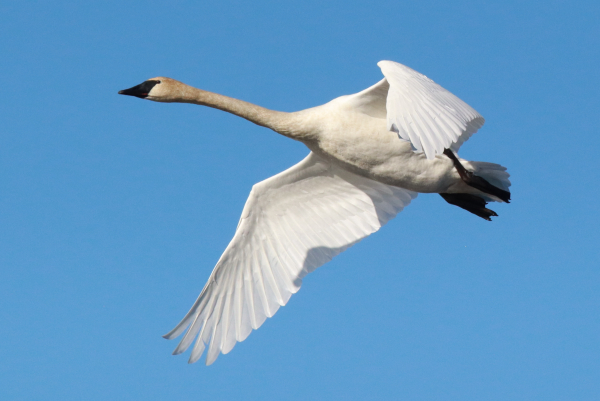
As if it was checking out the 3 amigos floating in a pontoon below, a graceful Trumpeter Swan flew overhead and into the late afternoon sunlight in central Minnesota last fall. Among the largest and heaviest of all flying birds, Trumpeters are the largest of the world’s 7 species of swans (October photo; 450mm zoom lens, f-8 aperture, 1/4000 shutter speed, 800 ISO).
My photo files of birds also tend to be a rolling travelog of what I am doing, where I am at, and what birds I encounter on a given day, week, month, or year. But I would be remiss to share these insights without sharing the birding equipment I use to take the photos I’m showcasing for you in this issue. All photos were taken with my basic Canon digital camera and a Tamron 150-to-600 zoom lens, and I must emphasize the importance of the quality and the magnification provided by the Tamron lens. Using the 600mm magnification has been a game changer for me as a bird photographer, primarily because of the technological addition of “Vibration Control (VC)” that allows me and anyone else to photograph birds without the “aid” of a tripod. Since switching to this lens, bird photography has been even more enjoyable and the quality of my photos has improved, with the combination making bird photography even more rewarding and productive!
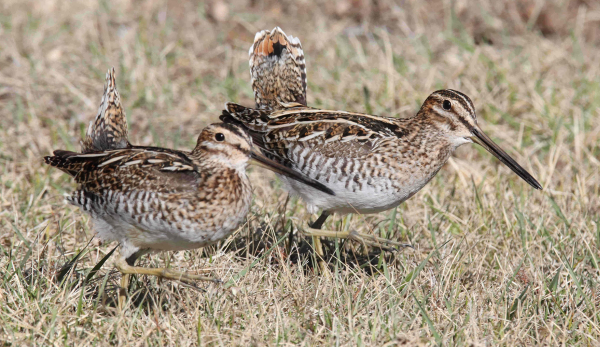
Leading me on a wild snipe chase near my home, a pair of Wilson’s Snipe displayed and called while on the run for a couple hundred yards, seemingly oblivious to the human with the black camera and lens following their springtime activities (April photo; 480mm zoom lens, f-9 aperture, 1/1600 shutter speed, 800 ISO).
Unless you already have a favorite camera lens that you are dialed in with, if you are looking to for a lens or want to improve the quality of your bird photographs (any photographs), consider the Tamron 150-to-600 zoom lens. If the price is a concern, consider paying for it with a credit card and paying $100 to your credit card company for the next 14 months (about $1,250 plus interest). Another option is to consider buying a slightly used Tamron 150-to-600 zoom lens if you can pay cash. Used lenses tend to be in like-new condition, and photographers tend to take care of their equipment like it was made of gold, so a used lens is a viable option. I consider using this lens as one of the best decisions I’ve made during the 2020s, and I obviously would recommend it to anyone interested in photographing birds and anything else that requires a level of magnification.

The beautifully textured colors of a Common Nighthawk stood out as it balanced on its unusual perch of barbed wire. Looking relaxed with its plumage fluffed a bit, the moody color reflecting from the marsh added a pleasing background that accents the nightbird (August photo; 600mm zoom lens, f-6 aperture, 1/2000 shutter speed, 800 ISO).
One more thing about the birds I photographed this year: I took more of the photographs with friends this year, and those photo sessions have brought us a little closer as friends, even helping to renew friendships. That may be a part of bird photography and birding in general that we may overlook at times. And as all my friends, family, and associates know, I’m compelled to share some new photographs that are especially exciting to me with a paragraph or two that I send via email that keeps us in touch, even if we are far apart geographically. I hope it’s been a rewarding year of bird photography for you, and hope you have more opportunities to visit places where birds abound, season after season, as you enjoy the new year ahead – 2026 – Happy New Year!

How Lucky can ya be? As 2 Golden Eagles soared toward me, even above me – close – gliding on remarkably long wings above the peak of a tall prairie butte, I followed their flights through my camera lens. How Exciting! But I stayed in the moment in spite of my heart racing as I pointed my camera at one young eagle, then the other as they approached, turned, and approached again with one extended its gliding flight until it was straight above me, close! (February photo; 600mm zoom lens, f-8 aperture, 1/3200 shutter speed, 800 ISO.)
Article and Photographs by Paul Konrad
Share your bird photos and birding experiences at editorstbw2@gmail.com